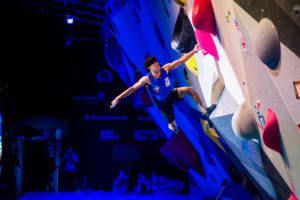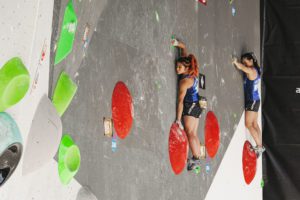One Indoor Exercise to Revolutionize Your Outdoor Bouldering
Outdoor climbers often refuse competition climbing as a distraction, but mock competitions facilitate another level of try hard

Whether you climb outside or compete indoors, the infinitely reducible problem of progression remains. Questions surrounding optimization and efficiency always pervade training conversations. In the past, we have discussed trying hard as a primary tool for progression. Unlocking that try hard is one of the hardest things to do in climbing and yet, every year, we watch competition climbers hit the mats with all of their strength and psych in each attempt.

Benefits of Competition Climbing
Although many outdoor climbers are reticent to try anything relating to competition, this is a weakness. Outdoor climbers will say that competition bouldering is not similar to rock climbing. While there may be fewer dynamic coordination sequences, coordination is a pillar of climbing. Regardless, the most essential aspect of competition climbing for non-competition climbers is trying hard in the moment. Dynamic movements aside, being able to climb within a few grades of your limit in one or two attempts is beneficial outdoors.
The problem with outdoor climbing is that the route never goes anywhere. This allows climbers to take their time to try and find the easiest sequence. This sort of beta reading has value, in fact it represents another pillar of climbing, but it comes without urgency. The five-minutes-on, five-minutes-off format of competition climbing forces the climber to consolidate all of their beta into one or two attempts.
This limited number of attempts trains a few things. The first is reading beta. You have to choose the best path that brings you the highest on the route. The second is rest. You have to balance the amount of rest you need for the problem against the rest you will need for the next problem against the score that score you will need to have a good round. Third, you will have to commit to your beta. Too often, outdoor climbers will give attempts to feel out the move.
The logic behind this is that you try the move without trying to stick the hold so that you can try many different betas and save energy for when you find the easiest beta. In a way, this makes sense, but finding the path in a single try offers greater efficiency. With that said, committing to your beta only really works if you pair it with this final competition element: try hard.

As you only have five minutes to complete the boulder problem in a competition, flashing is always more efficient. This rule is something to consider for outdoor climbing as well. Any attempt following your first two attempts on a boulder problem, unless you happen to fall extremely early on the route, will enter the land of diminishing returns. Not only will you face the consequences of your inefficiency on the problem, but you will face it again on the boulders that follow. The competition format punishes inefficiency.
As such, mock competitions make for one of the most exhausting and useful on-the-wall training exercises. For raw finger strength, nothing out competes board climbing, but for full body coordination, strength, technique, and power, the three-dimensional form of gym boulders offers different benefits than a 40-degree climbing wall.
Mock Competition
First, understand the format. You will pick five boulder problems. You are allowed five minutes to climb each of these five problems. The competition should begin directly after your warmup. You will receive five minutes of rest after each five-minute boulder problem. If you finish the problem before your five minutes runs out, you will rest for the remainder of that five-minute interval. You will then rest the additional five minutes allocated for the time between problems. The following competition shows this format.
Now that you know the format, you will pick your boulders. Pick your boulders based on your goals. If you hope to learn to flash, pick five boulders well beneath your limit. A V6 climber may pick five V4s for their first mock competition. Once you have an idea of how this format works, you may graduate to a more challenging mock competition. The difficulty is infinitely adjustable.
The more advanced format will pick five boulders of varying difficulties. Two or three of these boulders should be the hardest of what you are able to complete in your gym in a session. A V8 climber might pick two V8s, two V7s, and a V6. How you order them is up to you. With that said, do not read the beta in advance. To that effect, it is best if you have not tried these boulder problems before.
When you pick the problems, choose a Zone for each climb. The outdoor climber may think this redundant for their training, but it forces you to push higher than you might otherwise. If topping the climb were the only goal, and the climb was too difficult to Top in five minutes, you might give up in favour of resting. In fact, that would be tactically beneficial for the next climb. But if you score for Zones as well, it becomes worth your time to push into at least the Zone before resting.
The Consequence
Some will find it difficult to push hard on these problems. For those that need a little extra motivation, try the following additional rule. After the round concludes, you cannot try any other boulder problems except for those found in the round. If you complete all five problems during the round or afterwards, then you may move on to other boulders. This additional caveat may motivate you to send the boulder during your mock competition so you can get on with the rest of your session. Not only will it force you to try hard, it will show you what you could have done to flash that boulder problem.

Altogether, this workout takes 50 minutes making it an efficient power exercise. It exhausts while staying within the bounds of on-the-wall training. It facilitates trying hard and it forces precision, while simultaneously allowing for projecting following competition. Furthermore, it shows the value of rest and the importance of climbing problems in a short amount of time. These concepts all translate outdoors.
Perhaps one of the most important things you will learn is that you can climb harder in fewer attempts if you just try.


